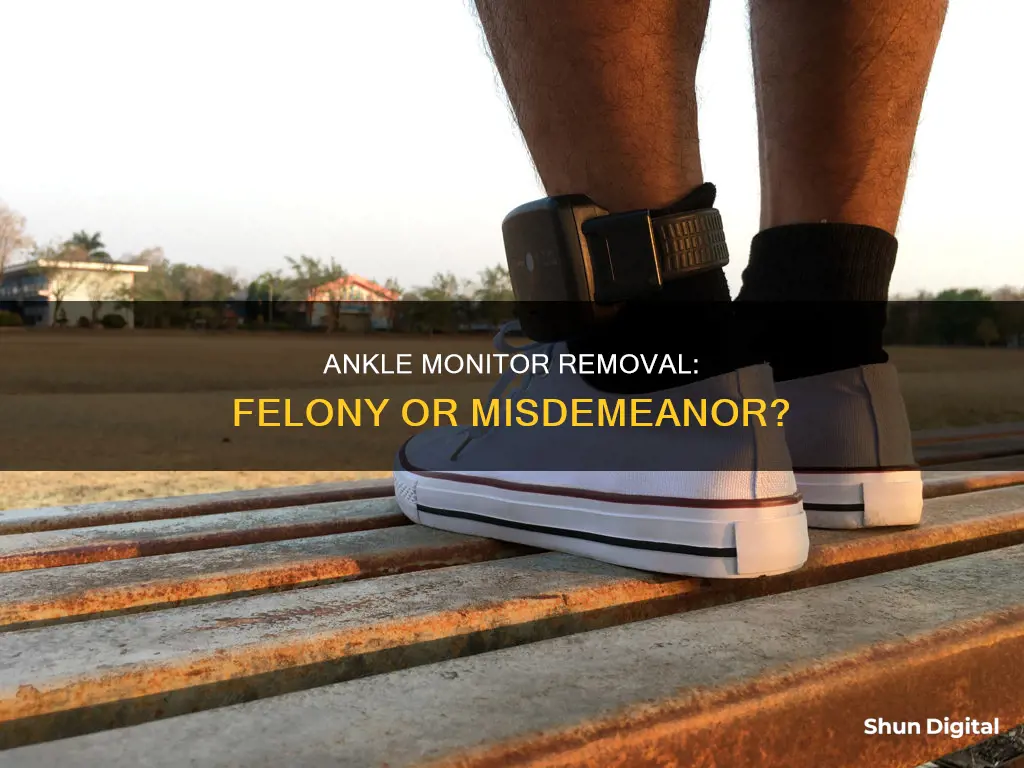
In Texas, cutting off your ankle monitor is a felony. This law was passed in 2023, after a man on parole and wearing an ankle monitor shot and killed two hospital workers in Dallas in October 2022. Before the law was passed, tampering with an ankle monitor was merely an administrative violation. Now, those found guilty of ankle monitor tampering face penalties ranging from 30 days in county jail to 25 years in prison.
| Characteristics | Values |
|---|---|
| Location | Texas |
| Effective date | 1st September 2023 |
| Type of crime | Felony |
| Type of ankle monitor tampering | State jail felony or third-degree felony |
| Penalty | 30 days in county jail to 25 years at the Texas Department of Criminal Justice |
What You'll Learn

Penalties for ankle monitor tampering in Texas
In Texas, penalties for ankle monitor tampering can result in serious consequences, including jail time and felony charges. Prior to the passing of Senate Bill 1004 (SB 1004) in 2023, tampering with an ankle monitor in Texas was considered an administrative violation. This meant that while it could trigger the offender's arrest and lead to consequences such as revoked bond or parole, it was not classified as a criminal offence.
However, the new law, which came into effect on September 1, 2023, has changed the classification of ankle monitor tampering to a criminal act, specifically a state jail felony. This means that individuals who tamper with or cut off their ankle monitors will now face an additional felony on top of their previous sentence. The specific penalty can vary, ranging from 30 days in county jail to 25 years in the Texas Department of Criminal Justice.
The bill was signed into law by Governor Greg Abbott in response to a tragic shooting at Methodist Hospital Dallas in October 2022. The suspect, Nestor Hernandez, was on parole and wearing an ankle monitor at the time of the shooting. He had previously violated his parole multiple times, including by cutting off his ankle monitor. The new law aims to increase accountability and prevent similar incidents from occurring in the future.
It is worth noting that there may be defences available for those accused of ankle monitor tampering. For example, technological glitches or accidental damage to the device could be argued as reasons for the tampering.
Easy Ways to Identify Your Monitor's Size
You may want to see also

Ankle monitor tampering as an administrative violation
Ankle monitors are often court-ordered as a condition of house arrest, community supervision, parole, or release on bail. They are used to track an individual's location and ensure they are adhering to the restrictions placed on them. While cutting off an ankle monitor may seem like a minor offence, it is considered a violation of the terms of one's release or supervision.
In the state of Texas, ankle monitor tampering is classified as an administrative violation. This means that while there are no direct criminal consequences for the act of cutting off the device, it does constitute a breach of the conditions set by the court or parole board. As such, law enforcement may be mobilised to arrest the individual, and they may be required to complete the remainder of their sentence or face other penalties.
The administrative violation can also result in the issuance of an arrest warrant, and the individual may be charged with "tampering with an electronic monitoring device" or "tampering with an electronic monitoring program". In Texas, this offence is classified as either a state jail felony or a third-degree felony, depending on the specific circumstances of the case.
It is important to note that the legal consequences of ankle monitor tampering can vary depending on the state and the specific circumstances of the case. While Texas currently does not impose criminal penalties specifically for cutting off an ankle monitor, other states may have different laws in place. Additionally, if an individual is a minor when they cut off their ankle monitor, their case may be handled differently once they reach the age of majority.
If someone suspects or knows that their ankle monitor has been tampered with or removed, they should seek legal counsel as soon as possible.
Monitor Hoods: Enhancing Your Viewing Experience
You may want to see also

Criminal charges for ankle monitor tampering
In other places, such as Florida, tampering with an ankle monitor is a third-degree felony, which can result in up to 5 years in prison and a $5,000 fine. Additionally, this conviction can count towards a habitual offender status, which can enhance the possible penalty.
It is important to note that even if a person is not caught immediately after tampering with their ankle monitor, they may still face legal consequences if they are apprehended at a later date. Seeking legal advice from a criminal defense lawyer is often recommended in such cases.
In terms of possible defenses for interfering with a court-ordered ankle monitor, one common argument is technological glitches. An attorney may argue that the ankle monitor malfunctioned or misidentified the correct location for reasons beyond the wearer's control. Another defense could be that the damage to the ankle monitor was medically necessary or accidental.
Adjusting Monitor Settings: Finding the Right Color Temperature
You may want to see also

Defenses for interfering with a court-ordered ankle monitor
Interfering with a court-ordered ankle monitor is a serious offense and can result in legal consequences, including arrest and additional charges. However, there may be certain defenses that an individual can raise if accused of interfering with their ankle monitor. Here are some potential defenses to consider:
- Accidental Interference: In some cases, individuals may accidentally interfere with their ankle monitor without intending to do so. For example, if the ankle monitor is damaged or tampered with unintentionally, it could trigger a false alert. An individual may argue that they did not intentionally try to remove or damage the device and that it was an accident.
- Necessity: If an individual can demonstrate that interfering with the ankle monitor was necessary to prevent harm or danger, it could be a valid defense. For instance, if the ankle monitor is causing physical harm or an allergic reaction, removing or interfering with it temporarily may be justified.
- False Alerts: Ankle monitors are not infallible, and sometimes they may malfunction or send false alerts. If an individual is accused of interfering with their ankle monitor, they may be able to argue that the alert was a false positive and that they did not intentionally try to tamper with the device.
- Inability to Pay: In some jurisdictions, individuals may be required to pay for the costs associated with the ankle monitor, including installation, monitoring fees, and maintenance. If an individual cannot afford these costs and fails to make payments, they could face additional legal consequences. However, a defense may be raised if the individual can demonstrate that they are unable to pay due to financial hardship.
- Violation of Rights: In certain cases, it may be possible to argue that the use of an ankle monitor violates an individual's constitutional or legal rights. For example, if the monitoring is deemed to be excessive or intrusive, an individual may be able to challenge the court order on those grounds.
- Inadequate Notice: Ankle monitors typically come with a set of rules and restrictions that the wearer must follow. However, if an individual is not properly informed of these rules or given adequate notice, they may have a defense if they inadvertently violate the terms of their monitoring.
It is important to note that the specific defenses available to an individual may vary depending on the jurisdiction and the circumstances of the case. Consulting with a legal professional who specializes in criminal defense or electronic monitoring cases is essential to understand the applicable laws and available defense strategies.
Monitor Graphics Card Failing: How to Spot the Signs
You may want to see also

Impact of age on responsibility for ankle monitor tampering
The impact of age on responsibility for ankle monitor tampering can vary depending on the individual's age and the specific laws and regulations in their jurisdiction. In general, tampering with an ankle monitor is considered a serious offence and can result in legal consequences. However, the specific consequences can differ based on the person's age and the circumstances of the tampering.
For minors, the consequences for tampering with an ankle monitor may be handled within the juvenile justice system. This could include a range of outcomes, from financial penalties to detention or other forms of punishment. In some cases, the individual may be held responsible for the cost of the monitor and any associated court or legal fees. The specific outcome will depend on the laws in the relevant jurisdiction and the discretion of the judge or authorities handling the case.
On the other hand, for adults, tampering with an ankle monitor is often considered a criminal offence and can result in felony charges. In some jurisdictions, it may be classified as a state jail felony or a third-degree felony, leading to significant jail time. The specific charges and penalties can vary depending on the individual's prior record, the circumstances of the tampering, and the laws in the relevant jurisdiction.
It is important to note that the consequences for ankle monitor tampering can be complex and vary on a case-by-case basis. Additionally, the age of the individual may play a role in mitigating or aggravating the perceived responsibility and subsequent consequences. It is always advisable to seek legal counsel to understand the specific laws and potential outcomes in a given situation.
Repairing LCD Monitor Power Supply Issues: A Step-by-Step Guide
You may want to see also
Frequently asked questions
Yes, in Texas, it is a felony to cut off your ankle monitor.
The consequences can range from 30 days in county jail to 25 years in prison.
One possible defense is technological glitches. An attorney may argue that a problem with the device itself caused it to stop working or misidentify the correct location.
There are three types of ankle monitors: radio-frequency, GPS, and alcohol/sweat (SCRAM) monitors.
Ankle monitors are used to track offenders and ensure they do not travel outside a specified boundary. They are commonly used for juvenile or low-level offenders, as well as for those on parole or probation.







